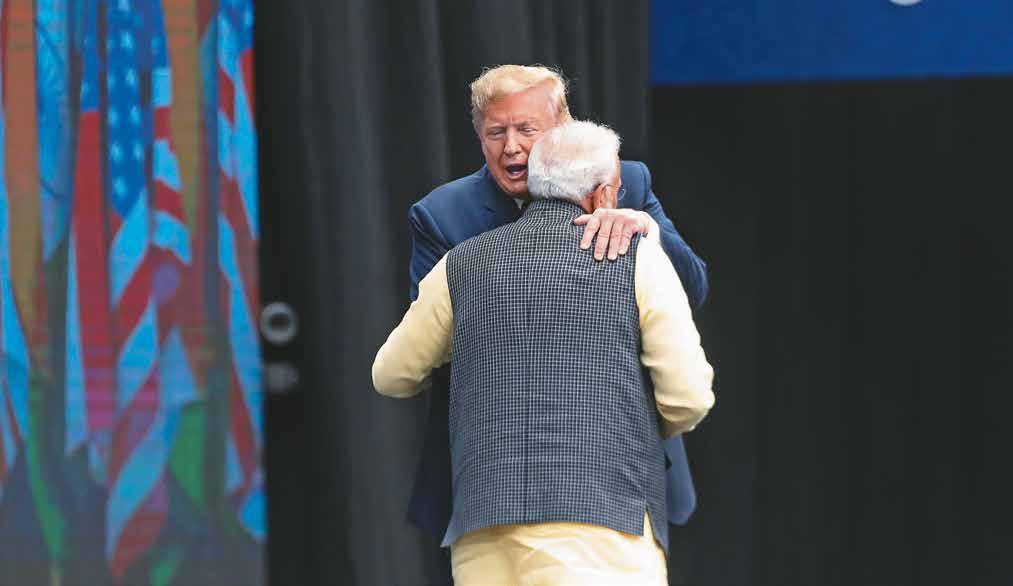An Ideal Couple?

UNLIKE China, Iran, Russia or the Middle East, the world’s most populous country, India, has barely been mentioned in the US presidential election cycle. India is fortunate in that even in a deeply polarised American polity, close relations enjoy strong bipartisan support. The ideal for New Delhi would be that the next president’s administration takes the final steps towards converting the current comprehensive, global and strategic US-India partnership into ‘‘the defining partnership of the twenty-first century”. On the policy front, references to India during the campaign cycle have only been in passing. Both candidates support robust India-US relations and both parties have long-time experts in their ranks who are keen to deepen the partnership.
If Donald Trump returns, his presidency is likely to be characterised by strong personal relations with Prime Minister Narendra Modi. These will be coupled with a transactional foreign policy where public differences over trade, market access and immigration will have to balance strategic imperatives. A President Kamala Harris, on the other hand, like President Joseph Biden, is more likely to focus on strategic convergences, in seeing India as the ideal counterweight to China, and not allowing differences to become divergences.
The bedrock of the US-India partnership has been shared values and mutual strategic interests. The multi-faceted US-India partnership is underpinned by strong commercial ties, close defense cooperation and shared strategic considerations.
India’s strategic location, economic potential and military capabilities make it an ideal partner for the United States in a key spot: continental Eurasia and the maritime Indo Pacific. India is also an important partner as the US seeks to pushback against the military and economic rise of China, both in the Indo Pacific and beyond. India’s own decades old rivalry with China further strengthen these shared interests.
Denne historien er fra November 11, 2024-utgaven av Outlook.
Start din 7-dagers gratis prøveperiode på Magzter GOLD for å få tilgang til tusenvis av utvalgte premiumhistorier og 9500+ magasiner og aviser.
Allerede abonnent ? Logg på
Denne historien er fra November 11, 2024-utgaven av Outlook.
Start din 7-dagers gratis prøveperiode på Magzter GOLD for å få tilgang til tusenvis av utvalgte premiumhistorier og 9500+ magasiner og aviser.
Allerede abonnent? Logg på

Coding Careers Climb, Consistently
As digital disruption accelerates, Outlook examines how a premier tech institute is changing the game with steady placement growth and sectoral shifts

Shaping Tomorrow's Leaders
Sri Siddhartha Academy of Higher education: pioneering teamwork and collaboration, offering a transdisciplinary approach for medical, engineering, and management students and research scholars

Building Leaders Through Innovative Education
PIMR Indore is nurturing innovative business leaders, entrepreneurs, thought leaders, policymakers, and agents of social change through research-driven and globally aligned transformative education

Big Dreams, Thin Cast
While India is expanding its foreign service to reflect its evolving role in the world order, it continues to be dwarfed by the diplomatic missions of China and other countries in both size and skill

Engineering Futures
Despite global economic challenges, a premier Indian engineering institute showcases its resilience with robust placement outcomes. Outlook takes a look

Education and Employability
In an ever-evolving employment landscape, Outlook examines a historic Indian university that demonstrates adaptability and growth through its placement outcomes

Shaping Agile Leaders
IMT Ghaziabad achieving excellence and nurturing leadership through knowledge, innovation, tech-readiness, entrepreneurial mindset and sustainability

From placements to Propel'ments
Rather than chasing a dwindling pool of entry-level jobs, young Indians can become creators and deployers of AI solutions that radically boost productivity across sectors

Speak, Memory
V.D. Savarkar is everywhere—in and outside the Andaman Cellular Jail—while the contributions of other revolutionaries who were imprisoned there receive little attention

KIET Flies High in Campus Placement
KIET Group of Institutions, Delhi-NCR, Ghaziabad with an impressive alumni strength of over 20000 students, speaks volumes of its popularity as a hiring campus for top global and Indian companies that abound in Delhi-NCR region
